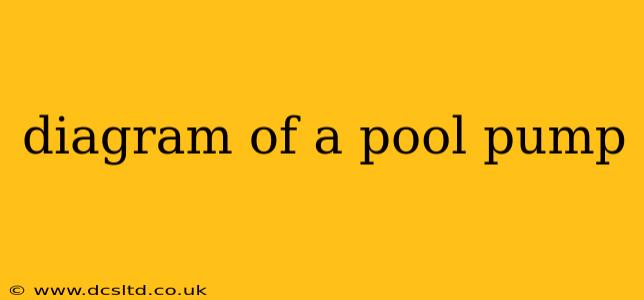A pool pump is the crucial component responsible for circulating water in your swimming pool, ensuring cleanliness and enjoyment. Understanding its components is key to maintenance and troubleshooting. While a single, comprehensive diagram can't capture every variation, this guide breaks down the essential parts and their functions, answering common questions along the way.
What are the main components of a pool pump?
A typical pool pump consists of these key elements:
-
Motor: The powerhouse, converting electrical energy into mechanical energy to drive the impeller. Different types exist, including single-speed, two-speed, and variable-speed motors, each impacting energy efficiency and operational costs.
-
Impeller: Located within the pump housing, this rotating component creates suction, drawing water into the pump. Its design significantly influences the pump's flow rate and pressure.
-
Pump Housing: This robust casing encloses the impeller and protects it from damage. It's usually made of durable materials like plastic or metal to withstand the constant pressure of water circulation.
-
Strainer Basket: Situated at the pump's intake, this basket filters out larger debris, preventing them from damaging the pump's impeller or clogging the plumbing. Regular cleaning is crucial for optimal pump performance.
-
Discharge Port: This opening expels the filtered water back into the pool plumbing system, typically leading to the filter.
-
Electrical Connections: These provide power to the motor, typically including a power cord and a connection box for safety and ease of access.
-
Plumbing Connections: These are the pipes connecting the pump to the pool, filter, and other equipment. Properly sized and sealed connections are critical for preventing leaks and maintaining water pressure.
What is the purpose of the pump strainer basket?
The pump strainer basket acts as a first line of defense against debris entering the pump. Leaves, insects, and other large particles get trapped in the basket, preventing them from clogging the impeller and damaging the pump. Regularly inspecting and cleaning the strainer basket is vital for maintaining efficient pool circulation and preventing costly repairs. A clogged strainer basket can also reduce the pump's efficiency and increase energy consumption.
How does a pool pump work?
The pool pump operates on a relatively simple principle:
-
Suction: The impeller's rotation creates suction, drawing water from the pool through the strainer basket and into the pump housing.
-
Pressure: The impeller then forcefully pushes the water out through the discharge port.
-
Circulation: This continuous process circulates the pool water, ensuring proper filtration and chemical distribution throughout the pool.
-
Filtration: The filtered water typically flows to the pool filter before returning to the pool.
How often should I clean my pool pump strainer basket?
The frequency of cleaning depends on factors like pool size, usage, and the surrounding environment. However, a good rule of thumb is to check the strainer basket at least once a week, and clean it as needed. If you notice a significant reduction in water flow or the pump struggling, it's a clear sign that the basket requires attention.
What are the different types of pool pumps?
There are several types of pool pumps available, each with its own advantages and disadvantages:
-
Single-Speed Pumps: These are the most common and least expensive type, running at a constant speed. They are generally less energy-efficient than other options.
-
Two-Speed Pumps: These pumps offer two speeds—high for cleaning and low for circulation—allowing for greater energy efficiency compared to single-speed pumps.
-
Variable-Speed Pumps: These advanced pumps can operate at a range of speeds, optimizing energy efficiency and performance based on your pool's needs. They are generally the most energy-efficient but also the most expensive upfront.
This overview provides a solid foundation for understanding the diagram of a pool pump and its functions. While a visual diagram would be helpful, this detailed description empowers you to understand the system's workings and conduct basic maintenance to keep your pool clean and your pump running smoothly. Remember to always consult your pool pump's manual for specific instructions and safety precautions.
